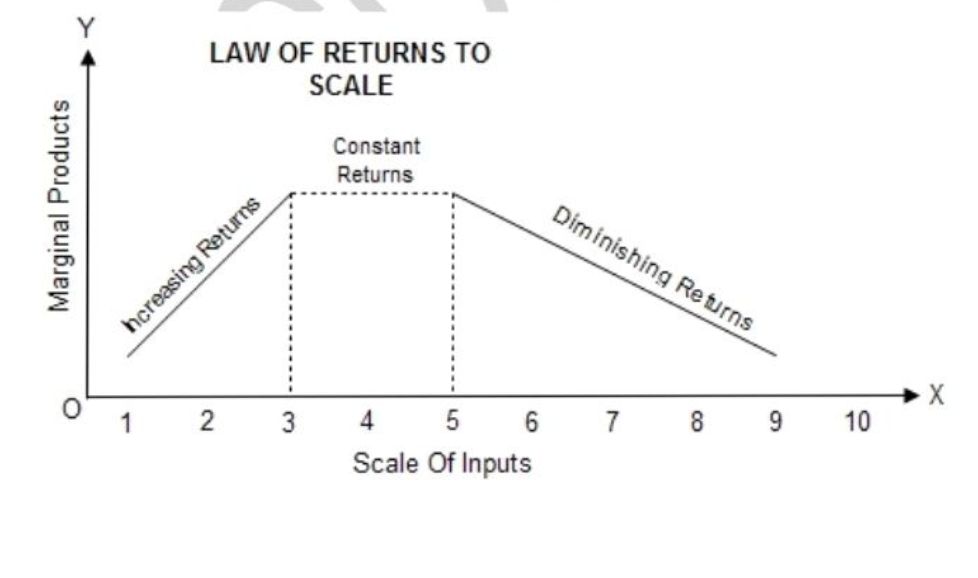Introduction:
Long run behavior of a firm is explained in terms of returns to scale that is the change in output as a result of change in all the inputs, proportion of input remains constant when all the inputs are changed in the same proportion we call this as change in scale of production. The way total output changes due to change in scale of production is called law of returns to scale. Thus, returns to scale means the effect on output when all the factors of production both fixed and variable are increase or decreased simultaneously in the same ratio. The explanation of the law of returns to scale is starts from assumptions
Assumptions of the law:
- All the factors are variable
- The state of technology remains constant
- There is perfect competition
- The output is measured in physical units
Law explanation:
The behavior of return to scale can be explained with the help of the following table:
| Acres of land | No. of workers | Total product (in quintals) | Marginal product return to scale |
| 3 | 1 | 2 | 2 |
| 6 | 2 | 5 | 3 |
| 9 | 3 | 9 | 4 |
| 12 | 4 | 14 | 5 |
| 15 | 5 | 19 | 5 |
| 18 | 6 | 24 | 5 |
| 21 | 7 | 28 | 4 |
| 24 | 8 | 31 | 3 |
| 27 | 9 | 33 | 2 |
The three stages are shown in the following diagram:

The law explains when we increase all the factors of production in the same proportion the marginal product increase at first then become constant and ultimately start declining hence we have three distinct faces of the behavior of marginal product which are explained below.
- Increase returns to scale: It means that the increase in output is more than proportional to the increase in input. for example if all the inputs are increase by 25% and the output increases by 40% then increase in return to scale operates
- Constant returns to scale: If increase in output is in the same proportion as the increase in quantity of all input, returns to scale are said to be constant. For example, if all the inputs are increased by 30% output also increase 30% and then return to scale are constant.
- Decreasing returns to scale: When the increase in output is at a smaller proportion then the increase in input, the returns to scale are decreasing. for example if inputs are increased by 50% but output increases by less than 50% say about 30% decreasing return to scale operates.
Causes of increasing returns to scale:
- Economies flowing from indivisibility: It means that certain factors are available only in some minimize or in definite range of sizes, if the same machine is used to produce 100 or 10000 of shoes then the fixed cost of machine will be spread over 10000 pairs in the cost per unit will be lower than before thus the scale of production increases.
- Economies of specialization of labor and machinery: As the scale of production increases efficiency of labor increases due to the division of labor and specialization of labor. in the same way when production increases it become possible to use specialized machine and services of specialized and expert management. This lead to higher productivity.
- Marketing and financial economies: The marketing cost of production per unit is lower in case of larger firm than in the case of a smaller firm. a larger firm is also able to rise funds from the public more cheaply than the smaller firms because they enjoy better reputation.
Causes of constant returns to scale:
- Limit of economies of scale: Increasing returns to scale has a limit due to the limit of the economy of scale when the economy of scale have been exhausted and the economies are yet to start, there may be a brief phase of constant returns to scale.
- Divisibility of input: In certain productive activities where the factors of production are perfectly divisible, constant return to scale may occur. for example the output may be double by setting up two plants which use the same quantity and the same type of workers, machines, raw material etc.
Causes of decreasing returns to scale:
- Complexity of management: When the scale of production is increased beyond manageable limit it leads to managerial inefficiency, like lack of proper coordination, bureaucracy, red tapism, lengthy chain of communication etc. due to this the management becomes complex and the overall efficiency of management decrease.
- Entrepreneur is a fixed a factor: Entrepreneur is a fixed and indivisible factor an increase up to the point where the abilities and the skill of their entrepreneur maybe fully utilized. Beyond this point his efficiency may be decrease as he is not able to manage things. This give rise to the diseconomies of scale.
- Exhaustibility of natural resources: In some economic activities the natural resources may be exhausted leading to decreasing returns. For example if the fishing fleet is doubled, the number of fish caught will not be double because the availability of fish may decrease when fishing is carried out an increasing scale.
also read: explain the degrees of elasticity of supply.